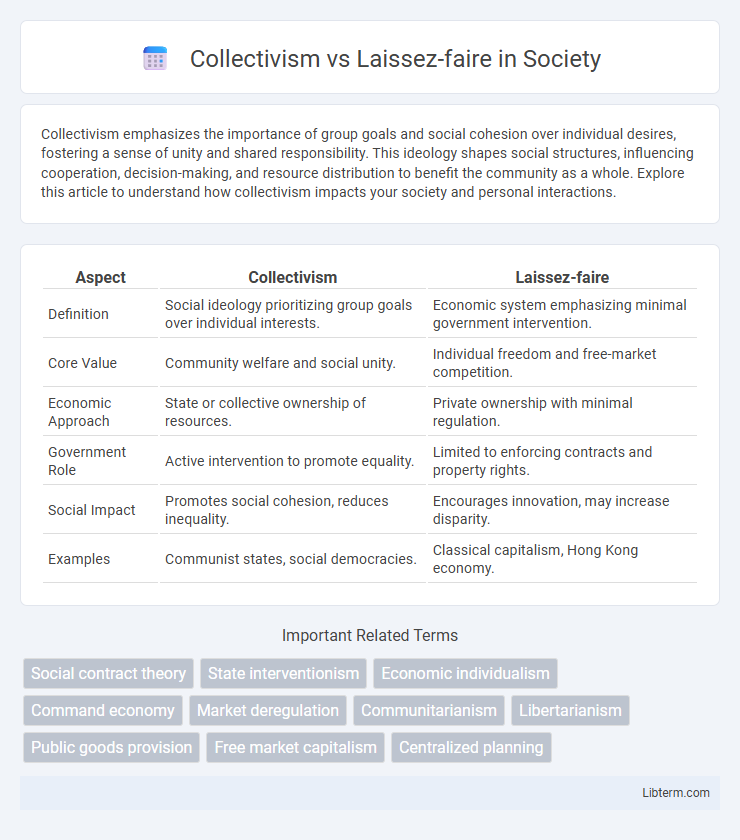Collectivism emphasizes the importance of group goals and social cohesion over individual desires, fostering a sense of unity and shared responsibility. This ideology shapes social structures, influencing cooperation, decision-making, and resource distribution to benefit the community as a whole. Explore this article to understand how collectivism impacts your society and personal interactions.
Table of Comparison
| Aspect | Collectivism | Laissez-faire |
|---|---|---|
| Definition | Social ideology prioritizing group goals over individual interests. | Economic system emphasizing minimal government intervention. |
| Core Value | Community welfare and social unity. | Individual freedom and free-market competition. |
| Economic Approach | State or collective ownership of resources. | Private ownership with minimal regulation. |
| Government Role | Active intervention to promote equality. | Limited to enforcing contracts and property rights. |
| Social Impact | Promotes social cohesion, reduces inequality. | Encourages innovation, may increase disparity. |
| Examples | Communist states, social democracies. | Classical capitalism, Hong Kong economy. |
Understanding Collectivism: Core Principles
Collectivism emphasizes the primacy of group goals over individual interests, advocating for shared ownership and cooperative decision-making to achieve social equity. Core principles include collective responsibility, equal distribution of resources, and prioritizing community welfare to ensure societal harmony. This ideology contrasts sharply with laissez-faire economics, which promotes minimal government intervention and individual autonomy in economic activities.
Defining Laissez-faire: An Overview
Laissez-faire is an economic philosophy advocating minimal government intervention, emphasizing individual autonomy in markets and private enterprise. It supports free-market capitalism, where supply and demand dictate prices and production without regulatory constraints. This approach contrasts sharply with collectivist systems that prioritize state control and communal ownership to achieve social equality.
Historical Origins of Both Approaches
Collectivism traces its roots to early socialist and communist ideologies of the 19th century, particularly influenced by Karl Marx's critique of capitalism and advocacy for communal ownership. Laissez-faire capitalism originated in the 18th century during the Enlightenment, strongly shaped by Adam Smith's principles of free markets and minimal government intervention. Both philosophies emerged as responses to the social and economic conditions of their times, shaping modern political and economic thought.
Key Philosophers and Influencers
Collectivism, championed by philosophers like Karl Marx and Jean-Jacques Rousseau, emphasizes communal ownership and social equality as foundations for political and economic organization. Laissez-faire economics, advocated by Adam Smith and later by Friedrich Hayek, promotes minimal government intervention, individual liberty, and free markets to drive economic growth. These key influencers shaped debates on governance and economic systems by arguing fundamentally different views on individual versus collective roles in society.
Economic Implications of Collectivism
Collectivism emphasizes state or group ownership of resources, leading to centralized economic planning and redistribution policies aimed at reducing inequality. This approach often results in greater social welfare provisions and public investment but can reduce individual incentives and market efficiency. Economic outcomes under collectivism typically include controlled prices, limited competition, and potential challenges in innovation and productivity growth.
Market Dynamics Under Laissez-faire
Market dynamics under laissez-faire emphasize minimal government intervention, allowing supply and demand to dictate prices and resource allocation efficiently. This approach fosters competition, innovation, and consumer choice, driving economic growth through decentralized decision-making. However, it may also result in market failures without regulatory oversight, potentially leading to monopolies and inequality.
Social Outcomes: Community vs Individualism
Collectivism emphasizes social outcomes that prioritize community well-being, fostering cooperation, social equality, and shared resources to address collective needs. Laissez-faire promotes individualism, encouraging personal freedom, self-reliance, and market-driven solutions that often lead to disparities in wealth and social status. The balance between these approaches influences social cohesion, with collectivism enhancing social support networks, while laissez-faire prioritizes personal achievement and economic competition.
Policy Examples: Real-world Applications
China's collectivist policies emphasize government control in economic planning, exemplified by state-owned enterprises dominating key industries. In contrast, Hong Kong's laissez-faire approach minimizes regulatory intervention, promoting free-market entrepreneurship and attracting global investment. These divergent strategies underline how collectivism fosters coordinated national growth, while laissez-faire encourages individual business innovation.
Pros and Cons: Comparative Analysis
Collectivism promotes social welfare and economic equality by emphasizing communal ownership and government intervention, enabling resource redistribution and public goods provision, but can stifle individual innovation and create inefficiencies due to bureaucratic oversight. Laissez-faire capitalism prioritizes individual freedom, encouraging entrepreneurship and market efficiency through minimal government intervention, which drives economic growth yet risks increased inequality and insufficient public services. Balancing these systems requires weighing collectivism's social safety nets against laissez-faire's incentives for productivity and innovation.
Future Trends in Governance and Societies
Emerging governance models increasingly blend collectivism's emphasis on social equity with laissez-faire principles that encourage innovation and market freedom, driven by digital transformation and decentralized technologies. Future societies may adopt hybrid frameworks leveraging blockchain and AI to balance collective welfare with individual autonomy, fostering sustainable economic ecosystems. These trends suggest governance will pivot toward adaptable, participatory structures prioritizing resilience and inclusive growth amid global challenges.
Collectivism Infographic

 libterm.com
libterm.com